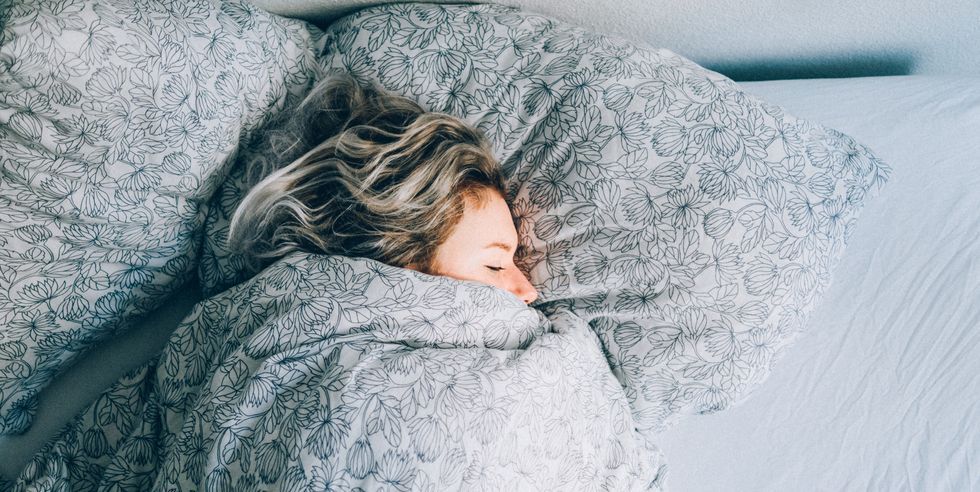Home » Health News »
The 5 Best Sleeping Positions For Lower Back Pain
Living with lower back pain can make you realize just how easy you had it when you were living a pain-free life. Lower back pain can make it a struggle to do basic, everyday things, like get out of bed, pick stuff up off the floor, or do pretty much anything else that involves movement.
If you’re a low back pain sufferer, know this: You’re not alone. A whopping 31 million people struggle with lower back pain at any given moment, according to the American Chiropractic Association. There are plenty of factors that can contribute to lower back pain, including genetics, how active you are, and previous injuries, but there are some things you can do to get relief.
One is tweaking your sleeping position. “Sleeping positions can affect back pain since there are some certain positions that contort the spine,” says Mark Slabaugh, MD, a sports medicine orthopaedic surgeon at The Orthopaedic Specialty Hospital at Mercy. “Since you spend a lot of time sleeping—hopefully six to seven hours—these positions can aggravate any spine issues that commonly affect the general population.”
No matter what position you sleep in, you want to try to allow for a neutral spine while you sleep, says Jason P. Womack, MD, chief of the Division of Sports Medicine and assistant professor in the Department of Family Medicine and Community Health at Rutgers Robert Wood Johnson Medical School. Meaning: Your head, neck, and back are in alignment, while allowing for the natural curves in each. “That will help prevent spasms of the muscle,” Dr. Womack says.
While switching up your sleeping position is unlikely to magically cure you of all your lower back pain, Dr. Womack says it can definitely help. Here’s what you need to know.
What are the best sleeping positions for lower back pain?
Ultimately, the best sleeping position for your lower back pain is the one that feels the most comfortable to you, says Neel Anand, MD, professor of orthopaedic surgery and director of spine trauma at Cedars-Sinai Spine Center in Los Angeles. “Every person is different,” he points out.

If you feel like your go-to sleep position might be aggravating your lower back pain, doctors recommend considering these.
Fetal position
Sleeping curled up on your side may help if you have back pain caused by a herniated disc, Dr. Womack says. In case you’re not familiar with what that is exactly, discs are the jelly-like cushioning between the vertebrae in your spine. A herniated disc is when part of that cushioning pushes out—and that can cause pain. Adding a pillow between your knees can also help straighten out your spine, he says.
On your side with a pillow between your knees
Sleeping on your side is one of the most common sleep positions, but it comes with a risk of your spine sagging in one direction while you sleep. That’s why Dr. Womack recommends adding a pillow between your knees to help straighten things out. “It props up the top leg, which makes the pelvis more neutral,” he says.
On your back
Sleeping on your back is “pretty good” for general lower back pain, Dr. Womack says, but he recommends being aware of how high your pillow is. “If it’s too high, it will prop up your neck too much,” he says. Cue more pain.
On your back with a pillow under your knees
If you’re a back sleeper but feel like you’re not totally in alignment while you sleep, Dr. Womack recommends putting a small pillow underneath your knees. “That will help prevent your pelvis from sticking up too much while you sleep,” he says.
On your stomach with a pillow under your pelvis
Sleeping on your stomach has a bad rap when it comes to back pain. “It can cause excessive curving of your spine,” Dr. Womack says. But, he adds, this position is doable if you place a pillow underneath your pelvis (this takes some of the pressure off your back). You can even skip the pillow under your head if you’re comfortable with it, to further keep things in alignment.
What should I look for in a pillow for lower back pain?
In general, you want to opt for a pillow that’s not too high or puffy, Dr. Womack says. “You don’t want anything that will prop your head up too much to where your neck is really bent,” he says. Instead, he recommends trying to find a pillow that will help line up your head with your shoulders.
“A pillow should be firm enough to support the weight of your body, but soft enough to be comfortable,” suggests Dr. Slabaugh, like one of these expert-recommended best pillows for back pain.
What should I look for in a mattress if I have lower back pain?
The rule of thumb with mattresses for back pain is pretty similar to what you should look for in a pillow, Dr. Slabaugh says. Meaning, you want a decent level of firmness, but don’t want to sleep on a rock. “Whether you sleep on your back or side, the mattress should give enough to allow you to have a straight spine,” he says.
Dr. Womack warns against soft mattresses. “People have more problems with mattresses that are too soft,” he says. “They get wear points and the areas that you normally put pressure on—around your knees and hips—can sink in deeper and create more trouble.”
Overall, doctors suggest looking for mattresses marked medium firm—like one of these expert-recommended best mattresses for back pain.
What can I do to relieve lower back pain in the morning when I wake up?
It can be a little tough on your back to start moving again after seven or so hours of sleep. In general, doctors say stretching your hamstrings can help loosen things up. “They tend to tighten up when we have back issues—it’s a protective mechanism,” Dr. Womack says. Stretching the area will “help take the pressure off” your back, he adds.
Wall slides—where you stand with your back up against a wall, and slowly raise your arms up and down on the wall—can also help get you in alignment in the morning, Dr. Anand says.
If you have a condition like spinal stenosis, which is a narrowing of the spaces in your spine that can put pressure on your spinal cord and the nerves in your spine, touching your toes “will feel great” on your back, Dr. Anand says. Just keep this in mind, per Dr. Anand: “If you feel pain when you’re stretching, stop.”
The bottom line: If you struggle with lower back pain, focus on keeping your spine straight and your knees, hips and neck in alignment.
Source: Read Full Article



